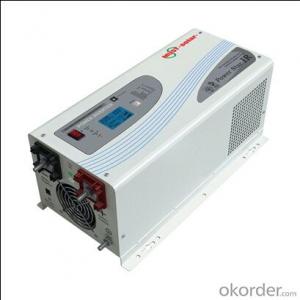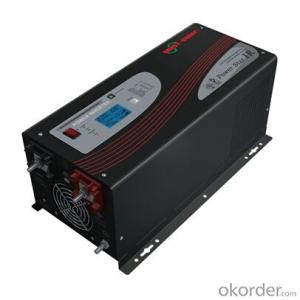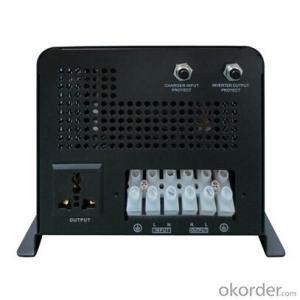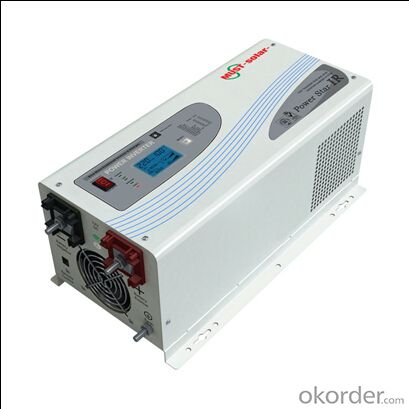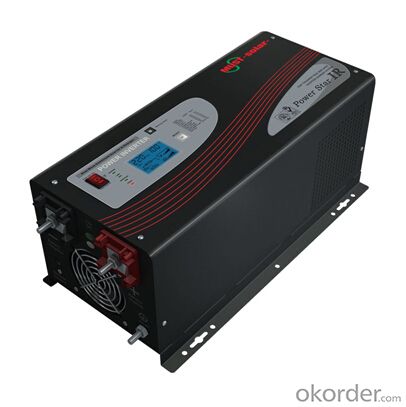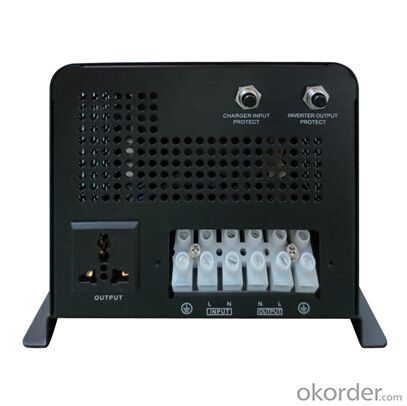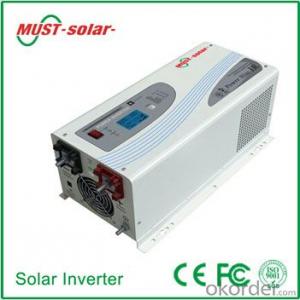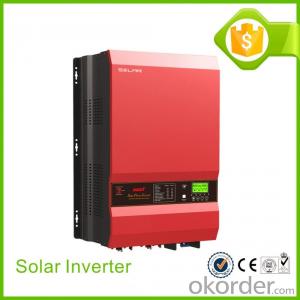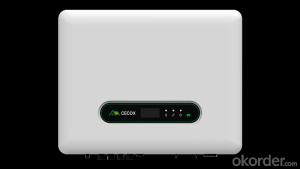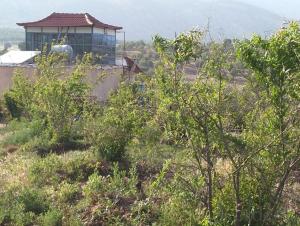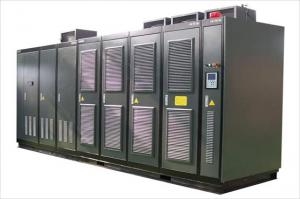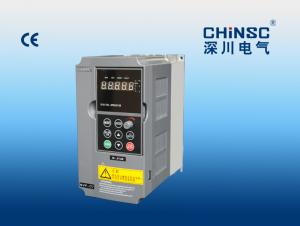4.2 Kw Off-Grid Low Frequency PV Inverter EP3200 Series 1Kw-3Kw
- Loading Port:
- China main port
- Payment Terms:
- TT or LC
- Min Order Qty:
- 30000 watt
- Supply Capability:
- 18000000 watt/month
OKorder Service Pledge
OKorder Financial Service
You Might Also Like
1. Structure of Off-Grid Low Frequency PV Inverter Description
A solar inverter, or PV inverter, or Solar converter, converts the variable direct current (DC) output of a photovoltaic (PV) solar panel into a
utility frequency alternating current (AC) that can be fed into a commercial electrical grid or used by a local, off-grid electrical network. It is a
critical BOS–component in a photovoltaic system, allowing the use of ordinary AC-powered equipment. Solar inverters have special
functions adapted for use with photovoltaic arrays, including maximum power point tracking and anti-islanding protection..
2. Main Features of the Off-Grid Low Frequency PV Inverter
• High overload ability of our EP3200 charger is up to 300% rated power
• EP3200 pure sine wave inverter adopts low quiescent current, and power saver mode to reduce power consumption to 3W
• It can extract max• power from various batteries with different protections, and low voltage trip can be selected (10V/10. 5V/11V)
• Uses PFC (power factor correction) for charger, which has less power consumption than conventional units.
• It has 10s delay before transfer when AC resumes, and overload protection when our APC pure sine wave inverter equips with generator
• 10ms typical transfer time between battery and AC, which guarantees power continuity of EP3200 charger. Uses selectable input AC
voltage (185-265V or 155-255V) for different kinds of loads
• Our EP3200 charger allows start up and through power with depleted batteries. Its powerful charge rate up to 70Amp
• It can offer 3-step intelligent battery charging, and equipped with 6 preset battery type selector for totally flat batteries
• LCD status display, battery/AC priority switch, RS232 communication port are available for our EP3200 pure sine wave inverter, it also has
17 alarms/warnings for easier operation and trouble-shooting, and ability to switch the unit on/off. In addition, select/deselect power saver
mode can be used too
3. Off-Grid Low Frequency PV Inverter Images
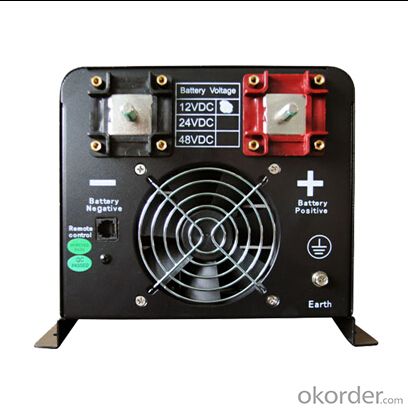

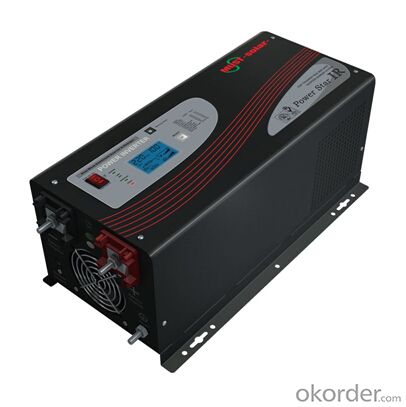

4. Off-Grid Low Frequency PV Inverter Specification
Rated Capacity | 1000W | 1500W | 2000W | 3000W |
Efficiency | >90% | |||
Input | ||||
Model | 120v Models | 230v Models | ||
Nominal Voltage | 100V/110V/115V/120V Selectable | 200V/220V/230V/240V Selectable | ||
Output | ||||
Rated Power | 1000W | 1500W | 2000W | 3000W |
Output Voltage | 100V/110V/115V/120V Selectable | 200V/220V/230V/240V Selectable | ||
Voltage Waveform | Pure Sine Wave | |||
Crest Factor | 3:01 | |||
Regulation(Nominal) | ±10% Typical Of Nominal Voltage | |||
Transfer Time | Transfer Time : AC To DC : 10ms (Typical) | |||
Transfer Time : DC To AC : 10ms(Typical ) | ||||
Max Bypass Overload Current | 30A | |||
Input | ||||
Nominal Voltage | DC12V/24V | DC12V/24V | DC12V/24V | DC24V/48V |
Over Current Protection | By Re-Settable Over Current Protector | |||
Output | ||||
Nominal Input Voltage | 230Vac | |||
Input Voltage Range | 185~265Vac | |||
Nominal Charge Current | 35amp-70amp | |||
Charger Short | Circuit Breaker | |||
Circuit Protection | ||||
Over Charge | Bat• V ≥ 15• 7Vdc/31• 4Vdc/62• 8Vdc | |||
Protection | Beeps 0• 5s Every 1s & Fault After 60s | |||
Battery Type | Lead-Acid 12Ah ~ 250Ah | |||
Typical Backup Time | No Limit, Depend on external battery | |||
Average Charging Current | 35A/20A | 45A/30A | 65A/35A | 75A/30A |
Battery voltage Option | ||||
Options 7 | Battery low trip to bypass 11v , high trip to battery 14v | |||
Options 8 | Battery low trip to bypass 10• 5v , high trip to battery 13• 5v | |||
Options 9 | Battery low trip to bypass 10v , high trip to battery 13v | |||
Communications & Management | ||||
Control Panel | LCD/LED Option | |||
Audible Alarm | Alarm On Battery:Low Battery & Battery Over Voltage | |||
Alarm On Abnormal Operation: | ||||
Over Load, Short-Circuit, & Over Heat | ||||
Environment and Safe | ||||
Operating Temperature | 0℃ To 40℃ (32℉ To 104℉) | |||
Transit/Storage Temperature | -15℃ To 60℃ | |||
Audible Noise | 60 Dba Max at 1m | |||
Quality Control System | ISO 9001,CE,FCC | |||
Physical | ||||
Dimensions: (H×D×W) | 570*320*315mm | |||
G• W (Kg) | 19 | 19 | 22.5 | 27.5 |
Packing | Export Carton For Each Unit Per Carton | |||
5. FAQ of Off-Grid Low Frequency PV Inverter
Q1 What is the difference between inverter and Off-Grid Low Frequency PV Inverter?
A1Inverter only has AC inpput, but Off-Grid Low Frequency PV Inverter both connect to AC input and solar panel, it saves more power.
Q2 What is the difference between MPPT&PWM?
A2MPPT has higher efficiency, it can track the max power point and won't waste energy.
Q3 What is the waranty of product?
A3 12 months.
- Q: Can a solar inverter be easily integrated into an existing electrical system?
- Yes, a solar inverter can be easily integrated into an existing electrical system. It is designed to convert the direct current (DC) power generated by solar panels into alternating current (AC) power that can be used by the electrical system. The inverter can typically be connected to the existing electrical system through a simple installation process, allowing the solar energy to be seamlessly integrated and utilized alongside the conventional power supply.
- Q: How do you connect a solar inverter to the electrical grid?
- To connect a solar inverter to the electrical grid, you need to follow a few steps. Firstly, you need to ensure that your solar inverter is compatible with grid connection. Then, you'll need to install an AC disconnect switch and connect it to your main electrical panel. Next, connect the solar inverter output to the AC disconnect switch using appropriate wiring. Finally, hire a licensed electrician to inspect and connect the inverter to the utility meter or main electrical service panel, ensuring compliance with local regulations and safety standards.
- Q: How does a grid-tied solar inverter function?
- A grid-tied solar inverter functions by converting the direct current (DC) generated by solar panels into alternating current (AC) that can be used to power appliances and feed back into the electrical grid. It synchronizes the AC power output with the grid's frequency and voltage, allowing excess electricity produced by the solar panels to be sent back to the grid, earning credits or reducing the homeowner's energy bill. It also ensures the system's safety by monitoring grid conditions and automatically shutting down during power outages.
- Q: Can a solar inverter be used with different battery chemistries?
- Yes, a solar inverter can be used with different battery chemistries as long as the inverter is compatible with the specific chemistry. However, it is important to ensure that the inverter is designed to support and optimize the charging and discharging characteristics of the specific battery chemistry being used for optimal performance and longevity.
- Q: What is the maximum number of parallel inverters that can be installed in a solar system?
- The maximum number of parallel inverters that can be installed in a solar system depends on the specific requirements of the system and the available infrastructure. There is no fixed limit, as it varies based on factors such as the size of the system, the capacity of the inverters, the electrical load, and the design limitations. It is best to consult with a solar system designer or engineer to determine the optimal number of parallel inverters for a particular solar installation.
- Q: How does a solar inverter handle shading or partial panel obstructions?
- A solar inverter handles shading or partial panel obstructions by employing a technique known as Maximum Power Point Tracking (MPPT). MPPT enables the inverter to optimize the output power of the solar panels by constantly adjusting the operating voltage and current. When shading or obstruction occurs, the inverter automatically detects the affected panels and adjusts their output to minimize the impact on the overall system performance. This ensures that the system continues to generate as much power as possible, even in shaded conditions.
- Q: Can a solar inverter be installed indoors or outdoors?
- A solar inverter can be installed both indoors and outdoors. However, it is generally recommended to install it indoors to protect it from harsh weather conditions and extend its lifespan.
- Q: How do you choose the right input voltage range for a solar inverter?
- To choose the right input voltage range for a solar inverter, it is essential to consider the specifications and requirements of both the solar panels and the inverter. The input voltage range of the inverter should be compatible with the output voltage range of the solar panels. It is important to ensure that the inverter can handle the maximum voltage generated by the panels during peak sunlight conditions. Additionally, factors such as temperature variations and system losses should also be taken into account while selecting the appropriate input voltage range for a solar inverter.
- Q: How does a solar inverter handle reactive power injection into the grid?
- A solar inverter manages reactive power injection into the grid through the use of power factor control techniques. It adjusts the phase relationship between the voltage and current to ensure that the power factor remains within acceptable limits. This is achieved by either absorbing or injecting reactive power as needed, helping to stabilize the grid and improve overall system efficiency.
- Q: Can a solar inverter be used with different types of grounding materials?
- Yes, a solar inverter can be used with different types of grounding materials. However, it is important to ensure that the grounding system is compatible with the specific requirements and guidelines provided by the manufacturer of the solar inverter. The grounding materials used should meet the necessary safety standards and provide proper electrical grounding for the solar installation. It is recommended to consult with a qualified electrician or solar professional to determine the appropriate grounding materials for your specific solar inverter and installation.
Send your message to us
4.2 Kw Off-Grid Low Frequency PV Inverter EP3200 Series 1Kw-3Kw
- Loading Port:
- China main port
- Payment Terms:
- TT or LC
- Min Order Qty:
- 30000 watt
- Supply Capability:
- 18000000 watt/month
OKorder Service Pledge
OKorder Financial Service
Similar products
Hot products
Hot Searches
Related keywords
